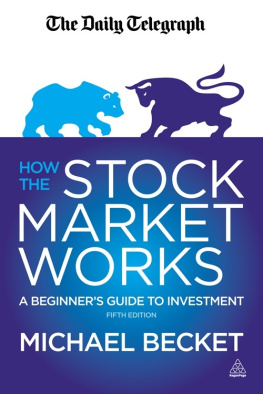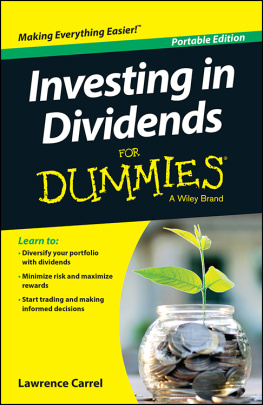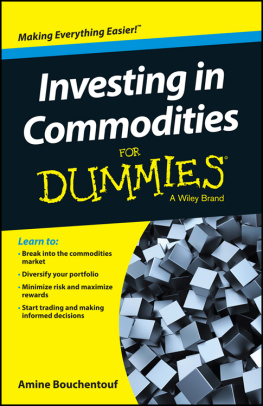Publishing details
HARRIMAN HOUSE LTD
3A Penns Road
Petersfield
Hampshire
GU32 2EW
GREAT BRITAIN
Tel: +44 (0)1730 233870
Fax: +44 (0)1730 233880
Email: enquiries@harriman-house.com
Website: www.harriman-house.com
First published in 1992, this edition published by Harriman House in 2008.
Reprinted in 2010.
Copyright Harriman House Ltd
The right of Jim Slater to be identified as the author has been asserted
in accordance with the Copyright, Design and Patents Act 1988.
ISBN: 978-0-85719-092-5
British Library Cataloguing in Publication Data
A CIP catalogue record for this book can be obtained from the British Library.
All rights reserved; no part of this publication may be reproduced, stored in a retrieval system, or transmitted in any form or by any means, electronic, mechanical, photocopying, recording, or otherwise without the prior written permission of the Publisher. This book may not be lent, resold, hired out or otherwise disposed of by way of trade in any form of binding or cover other than that in which it is published without the prior written consent of the Publisher.
No responsibility for loss occasioned to any person or corporate body acting or refraining to act as a result of reading material in this book can be accepted by the Publisher, by the Author, or by the employer of the Author.
Acknowledgements
I would like to thank Jeremy Utton for the idea that I should write a book on investment. His suggestion coincided with my son, Mark, finding a dearth of British books on the subject.
I would also like to thank Jeremy and my friends Sir James Goldsmith, Ian Watson, Bryan Quinton, George Finlay, Ralph Baber and Peter Greaves for reading the proofs and making some very constructive and helpful suggestions for improving the text.
Thanks are also due to Dr. Marc Faber for allowing me to quote him so extensively on Emerging Markets. Also a special word of appreciation to Warren Buffett for writing and saying so many interesting things about investment and allowing me to use them in this book.
I am also grateful to Brian Marber for the interview on technical analysis, for his comments and for his amusing stories.
My two sons have also been most helpful: Christopher by drawing his two cartoons and the bull and the bear, and Mark for long days of diligent work on the proofs, for his time and effort on research and for his many ideas for uplifting the content.
I would not live to tell the tale unless I included Pam Hall, my long-suffering secretary, who has typed most chapters so many times that she knows some of them by heart.
Preface to the 1992 edition
One of my sons is interested in the stock market. After reading a number of quite advanced American books on investment, he asked me if I could recommend a British book of a similar nature. I searched my mind and then the bookshops, only to find that there was nothing beyond the primer stage. Market forces usually begin to fill a gap; hence my decision to write this book. I have no doubt that many others will follow.
My intention is to show you how to become a very successful investor. My problem is that I do not know if you are an aspiring trainee stockbroker; an accountant or a lawyer who has an understanding of many of the rudiments of investment; or someone who is in a very different line of business or who has retired after a lifetime in industry. I do not want to bore the people who understand the basics, so I shall assume that you are connected with the business of investment in some way or that you have read the Glossary at the end of this book. Either way, you will then know the difference between an ordinary share, a preference share and a convertible debenture; the meaning of terms like price earnings ratio, dividend yield and asset value; and the effect and significance of scrip and rights issues.
There are a number of different methods and areas of investment, some of which I will explain to you in much more detail in later chapters:
Small dynamic growth companies
Fast-growing companies with market capitalisations ranging from 5m to 100m are not researched frequently by the investment community, so their shares are often exceptionally attractive.
Turnaround situations and cyclicals
Companies that have been hit hard by a recessionary environment or other exceptional factors are often due for a rebound. These situations involve cyclical companies and those which have recently had a change of management.
Shells
Shells are another exciting medium of investment. These are often very small companies that have a quotation, a small, nondescript business of little account and occasionally some cash. Usually, the idea of the incoming entrepreneur is to obtain a backdoor quotation for his company, which has too short a record, or some other shortcoming which precludes a more conventional route. There are many examples of successful and sometimes infamous shells from Hanson and Williams Holdings to Polly Peck and Parkfield. The ride can be very exciting.
Asset situations
Some of my friends invest solely in companies in which the shares have a market value less than the worth of the underlying businesses on a break-up. These value investors wait for a trigger, such as a bid or the arrival of new management, to revitalise the assets and bring them up to their full earnings potential. The shares then begin to appreciate in value.
Leading stocks
Companies in the FT-SE 100 Index usually offer the comfort of size and rarely fail completely. These kinds of shares can also be sold much more easily even in bad markets. They are, however, well analysed by the investment community, increasing the difficulty of finding a real bargain. I intend to give you some selective criteria that should improve your investment performance with leading shares in this country. I have also found that my criteria work extremely well in America and most overseas markets.
If you need to read the Glossary please do so now, as I am anxious to show you how to make some money by using an approach that I have named The Zulu Principle. You will not be spending any time on gilts, preference shares, loan stocks and the Japanese market. Instead, you will concentrate upon five different ways of making money by investing in ordinary shares before you finally select one method or perhaps two that suit your temperament.
I first named this approach The Zulu Principle after my wife read a four page article on Zulus in Readers Digest . From that moment onwards she knew more than me about Zulus. If she had then borrowed all the available books on the subject from the local library and read them carefully she would have known more about Zulus than most people in Surrey. If she had decided subsequently to visit South Africa, live for six months in a Zulu kraal and study all the available literature on Zulus at a South African University, she would have become one of the leading authorities in Great Britain and possibly the world. The key point is that the history of Zulus and their habits and customs today is a clearly defined and narrow area of knowledge into which my wife would have invested a disproportionate amount of her time and effort, with the result that she would have become an acknowledged expert. The study of this noble people might not have been profitable, but there are many other very specialised subjects that would have been very rewarding financially.
I now intend to show you how to use The Zulu Principle with your investments. You will achieve your objective, like Montgomery and Napoleon before him, by concentrating your attack.









